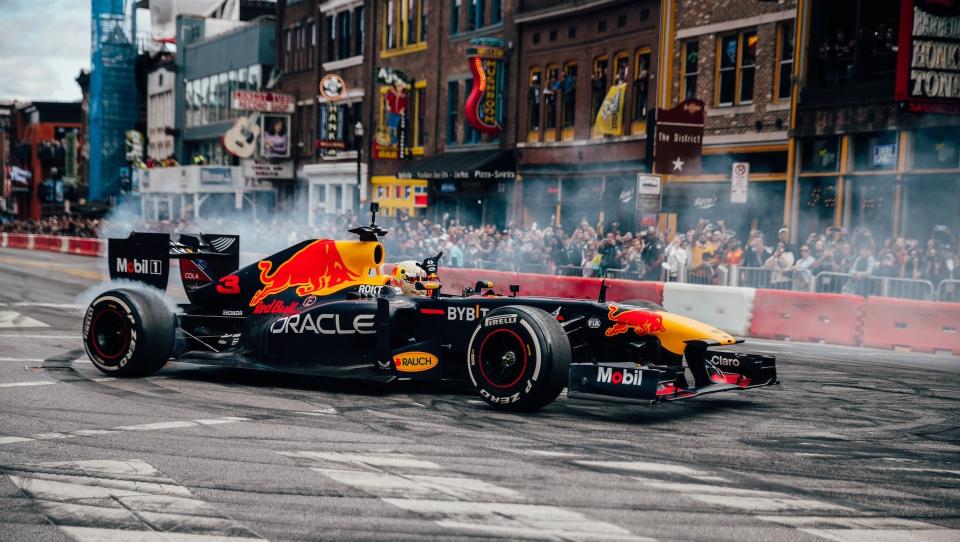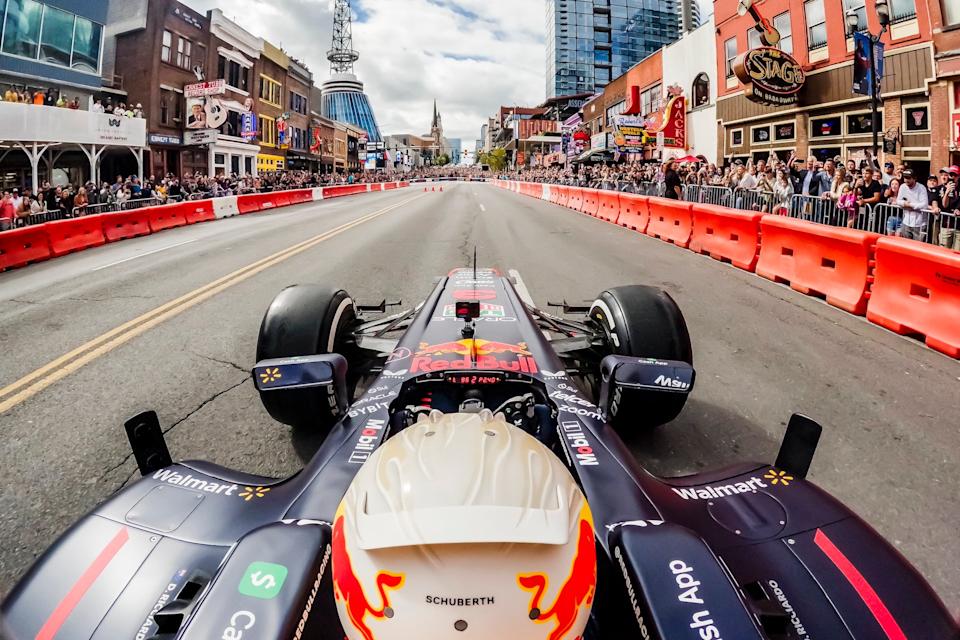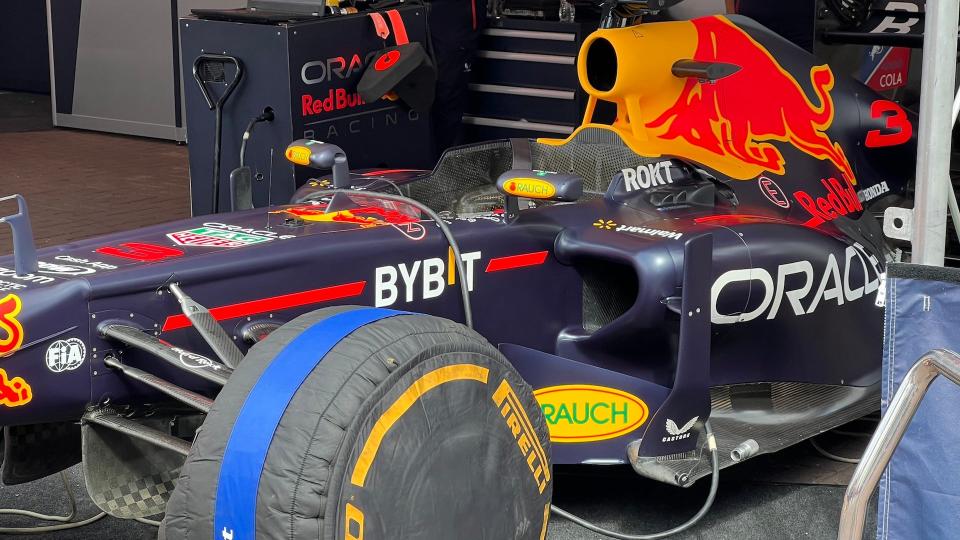Modifying a Red Bull F1 Car Into a Drift Machine Is Way Harder Than It Sounds

A Formula 1 car is a purpose-built vehicle with an extremely short list of possible uses. It's not designed to be the fastest car in a straight line; that's a Top Fuel dragster. It's not designed to be the fastest on an oval; that's an IndyCar racer. And while it can be driven in wet conditions, its own fragility—and not to mention extremely low ride height—renders it useless outside of a world-class road course. Making matters even worse is the fact that F1 cars are far from being plug-and-play machines, requiring loads of computers and engineers just to fire up the engine.
The radical-thinking folks at Red Bull, however, have managed to tweak F1 cars to run everywhere from skyscraper heliports to frozen lakes, and even the Florida Everglades over the years, defying their very single-purpose nature. But how exactly do they do it?



I recently caught up with Australian F1 superstar Daniel Ricciardo and Red Bull Racing's Heritage Team Manager Tony Burrows to find out what it takes to run and drive an F1 car on the streets.
From Monaco to the Music City
The arsenal for the Red Bull Showrun Nashville consisted of a modified 2011 RB7 with a shrieking V8 engine (pre-hybrid era), which a fully recovered Ricciardo used to generate enough tire smoke to engulf hundreds of country music bars and thousands of fans lining the world-famous Broadway Street. More importantly, though, this marked the Honey Badger's return to the cockpit of an F1 car after he severely hurt his hand in a crash at the Dutch Grand Prix in August.
Now, bringing an F1 car—or two—to these somewhat remote locations (in the sense that they are far from world-class race tracks) is no easy task and requires lots of logistical work.


"There are 12 of us in the team responsible for bringing two RB17s around the world," Burrows told The Drive. "There are two engine engineers, two systems engineers, mechanics, management, marketing, and so forth. We have our own jobs back at the factory in Milton Keynes with the racing team, but with the banning of testing we find ourselves with a lot more time on our hands so we get asked to go out and have some fun."
Red Bull F1 designers and engineers spend nearly every waking hour optimizing their race cars to go as quickly, safely, and efficiently as possible around the season's race tracks. With most F1 races taking place about the same time every year, teams build enormous caches of historical performance data to help them fine-tune their cars. You can see how randomly showing up at the parking lot of the United Center in Chicago or Nashville's downtown streets—places where very few people knew F1 even existed until the sport's recent explosion—would be extremely unorthodox.
"The biggest challenge at every Showrun has to do with the surface of the road, so the smoother the road, the better the show will be because we can go faster and we have a lot more control of the car," said Burrows. "In roads in bad condition, the car is slightly out of control when going over the surface so we have to keep the speeds down.
"Safety is obviously paramount so it helps when the course is as wide as possible so we can do our thing safely. Sometimes when you go places and it's so narrow you don't feel safe to do anything. This is a great track here in Nashville with some big spaces and big intersections where we can really show off," he added.





Drivers, too, typically race on a lot of the same tracks from a very young age, as the junior racing series typically visit the same venues as the bigger series. This means it's not very often that drivers have to learn completely new tracks. Even as a veteran of the sport, Ricciardo still has to adjust his mindset, vision, and reflexes to driving in such a unique environment as Broadway Street.
"I always worry that the donut space is super narrow, so I'm always like, 'Uhhhhh!' But this space was pretty generous and we had plenty of room," Ricciardo told The Drive. "There was a bit of water in some areas so it was a bit slippery but it was okay. You know, it's not about going super fast—as long as we can create some noise and some smoke the people are pretty happy. Once you get the first set of donuts done you can feel a bit more relaxed."
While Ricciardo and Burrows analyzed the street surface the morning of the show to identify potential hazards like deep ruts or oversized potholes, Ricciardo had another more important issue at hand—literally.

"I figured Nashville was a good way to warm up because Austin has always been the target to return [after the crash at Zandvoort]," said Ricciardo. "I would've loved to come back earlier but I knew for a while that this Showrun was scheduled so I was like, alright, maybe Nashville will be a good chance to get behind the wheel to get a good feel for the hand.
"I did a little bit of simulator the week before and that felt pretty good, so yeah, feel good now. Of course, donuts are a little easier [and didn't have to practice those in the simulator] but there's still some fatigue. This was still a nice little warm-up."
Showrun Mods
After seeing the RB7—once piloted by Sebastian Vettel and Mark Webber during the 2011 season (two years before the infamous "Multi 21" fiasco)—doing its thing in Chicago and later on in Nashville, it was evident that no F1 car is designed to do this. In a world where F1 car parts are produced with surgical precision under extremely rigorous conditions, beating the leaving daylights out of the car to get a cheer from the crowd almost feels sacrilegious—almost.
"The car doesn't like it very much," laughed Burrows. "It's designed to run on billiard-table flat race tracks, so bouncing over manholes and bumps and trenches dug in the tarmac, it doesn't like it very much. The car does OK as long as we can tweak the suspension and ride height to get it far enough off the ground so it doesn't smash itself into the tarmac."



According to Burrows, the traveling RB7 is about 90% identical to when it finished its last official F1 race, though several modifications have been made so it doesn't grenade itself.
Of everything that happens at these street runs, it's the never-ending donuts that really make the show what it is. It's the type of thing you can't witness anywhere else. However, this is also what beats up the car. The heat generated by the engine and other components is further compounded by the monumental lack of airflow going through the car due to the short running distances. A recipe for disaster, without the proper precautions.
"The biggest modification we do to the car has to do with cooling," explained Burrows. "The internals of an F1 car are designed to be cooled at about 200 mph—that's the car's efficient cooling rate. Below that speed things cool less efficiently, especially driving up and down streets that are just 200 or 300 meters long. Things get hot and the car doesn't have time to cool.
"We fit fans in these cars that are running all the time and blast air into the top of the radiators. They're fixed onto the chassis and wired to the ignition, so they start running when the car fires up. These are also fitted with dry ice cages, which help the fans suck in frozen oxygen [via sidepod air intake] and blow it into the radiators to keep the engine cool," he added. "These really help keep the engine cool, especially when the car is doing donuts because there is no forward motion when it's going in circles. You need to keep pulling the air in from somewhere."





Other areas like brake balance are also adjusted to help the car perform its tricks. More intricately, however, is the work performed on the gearbox to make sure the clutch, internal gears, seals, and other bits last.
"Brake balance is adjusted a long way forward in order to pin the front wheels while the rears are breaking free to do donuts," said Burrows. "We burn a lot of clutches mainly because of the donuts. While doing donuts, the driver is constantly pulling the [steering-wheel-mounted] clutch in and out, and also while trying to slow the car down. This RB7 will do 60 mph in first gear without touching the throttle, so you're constantly pulling the clutch in while applying the brakes to slow down. Formula 1 cars don't like that—normally in a race you touch the clutch when leaving the garage and when you take off and you never touch the clutch again."
Mainstream in America
I've been watching F1 for just about three decades, and I never thought I'd see an F1 car tearing up the same Nashville city streets where roofless buses carrying drunk partygoers are the norm. Yes, Netflix really shoved F1 down America's throat, but the pinnacle of motorsport is now a mainstream sport in the U.S. It may not get the same TV ratings as ball sports, but people know what it is and they know the main players. Hell, I overheard a Nashville local standing next to me talking to their friends about how Ford and Cadillac are joining the sport. That's huge.

As for the Heritage team that puts on these incredible shows, they're off to Sin City next. The inaugural Las Vegas F1 Grand Prix in November is providing them with a unique opportunity to run the ear-piercing RB7 for what will surely be a huge crowd. Whether you're hanging out on the streets, stands, or the $13,000-a-ticket Red Bull Hozhaus Energy Station, there's nothing quite like seeing an F1 car with underglow lights shredding rubber on closed public roads.
Email the author at jerry@thedrive.com

 Yahoo Autos
Yahoo Autos 